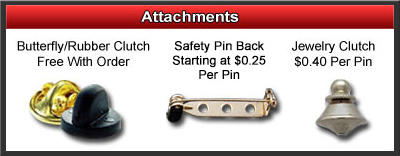Custom Soft Enamel Lapel Pins
Soft enamel lapel pins are the most economical and common pin sold. Soft enamel lapel pins are an excellent way to market and brand your organization or business. Custom soft enamel lapel pins are used for service awards, employee recognition, advertising and much more. Some other excellent reasons to use soft enamel lapel pins are trade shows, large events, trading sport pins, concerts or just any reason to get people to notice your cause.

Soft Enamel Lapel Pin Pricing
Soft Enamel Lapel Pin Pricing
| 100 | 200 | 300 | 500 | 750 | 1000 | 2000 | 3000 | 5000 | 10000 | |
| 3/4″ | $4.01 | $3.42 | $2.48 | $2.05 | $1.85 | $1.60 | $1.57 | $1.33 | $1.14 | $0.91 |
| 1″ | $4.04 | $3.55 | $2.62 | $2.16 | $1.94 | $1.66 | $1.62 | $1.37 | $1.20 | $1.02 |
| 1.25″ | $4.14 | $3.80 | $2.81 | $2.26 | $2.02 | $1.70 | $1.68 | $1.44 | $1.30 | $1.06 |
| 1.50″ | $4.42 | $4.07 | $3.30 | $2.44 | $2.16 | $1.85 | $1.82 | $1.56 | $1.42 | $1.14 |
| 1.75″ | $5.03 | $4.60 | $3.73 | $2.93 | $2.62 | $2.27 | $2.24 | $2.05 | $1.84 | $1.78 |
| 2″ | $5.26 | $4.84 | $4.00 | $3.17 | $2.87 | $2.50 | $2.47 | $2.32 | $2.05 | $2.03 |
No mold fee regardless of pin count.


There are a wide variety of attachments available for soft enamel lapel pins. A butterfly/rubber clutch is the standard attachment and is free with your order. Safety pin backs and jewelry clutches can be applied to your soft enamel pins at a small additional cost. Consider increasing the impact of your soft enamel pins by ordering presentation cases, printed card stock, or really catch the eye with the addition of a simulated gemstone.
Metal Plating Choices

How custom soft enamel lapel pins are made.
Soft enamel lapel pins begin as a custom die made from your artwork. That die then stamps a metal sheet, imprinting your image into the metal, and is plated your choice of gold, silver, copper or black metal The recessed areas are colored one color at a time with a high quality enamel paint and kiln fired. A clear epoxy coating can be added for additional protection at no additional charge.
Soft enamel lapel pins have become more and more popular because of their beautiful appearance and value. Because soft enamel pins can be made into custom shapes and have the appearance of fine jewelry they have become the number one choice for company pins, club pins and organizations. They are also popular for awards, years-of-service, and special event pins.

A soft enamel lapel pin, hard enamel lapel pin and a die struck lapel pin all would start off with the same raised and recessed base. The hard enamel style would be filled and fired for almost twice as long and then polished to give it a jewelry like finish. The soft enamel style is just fired at a lower temperature for a shorter amount of time and coated with a clear epoxy for a luster finish.
Just click on the Free Quote button or Get Started Now button located at the top of the page to get started.



